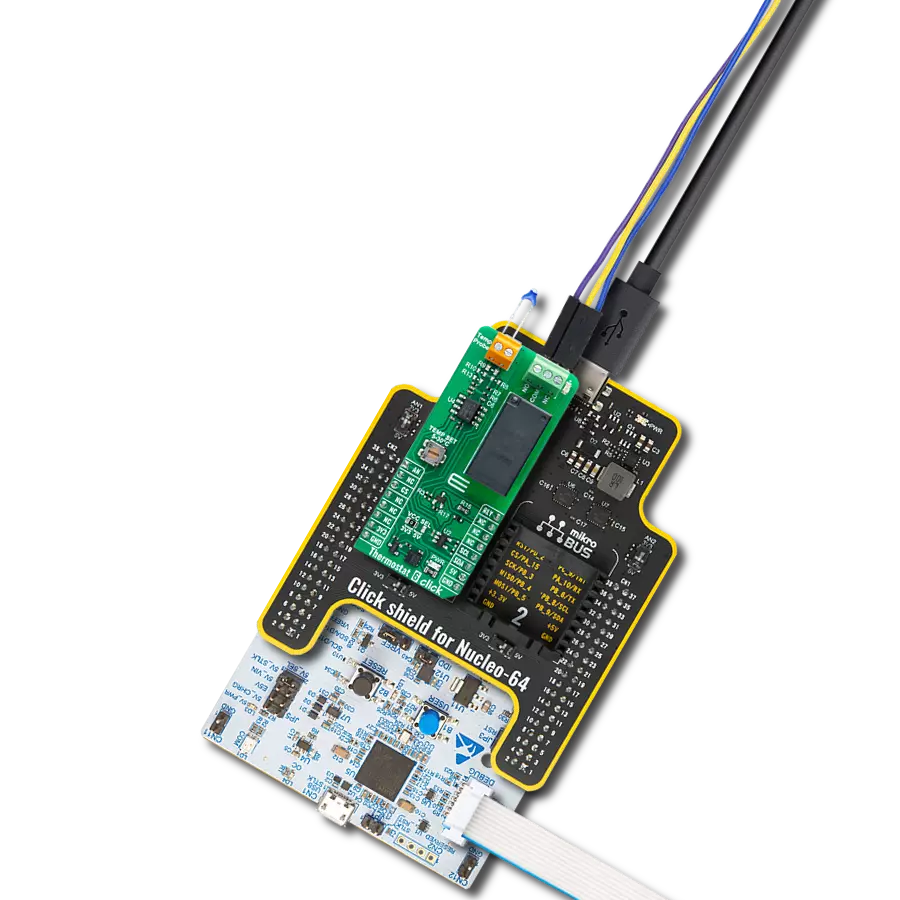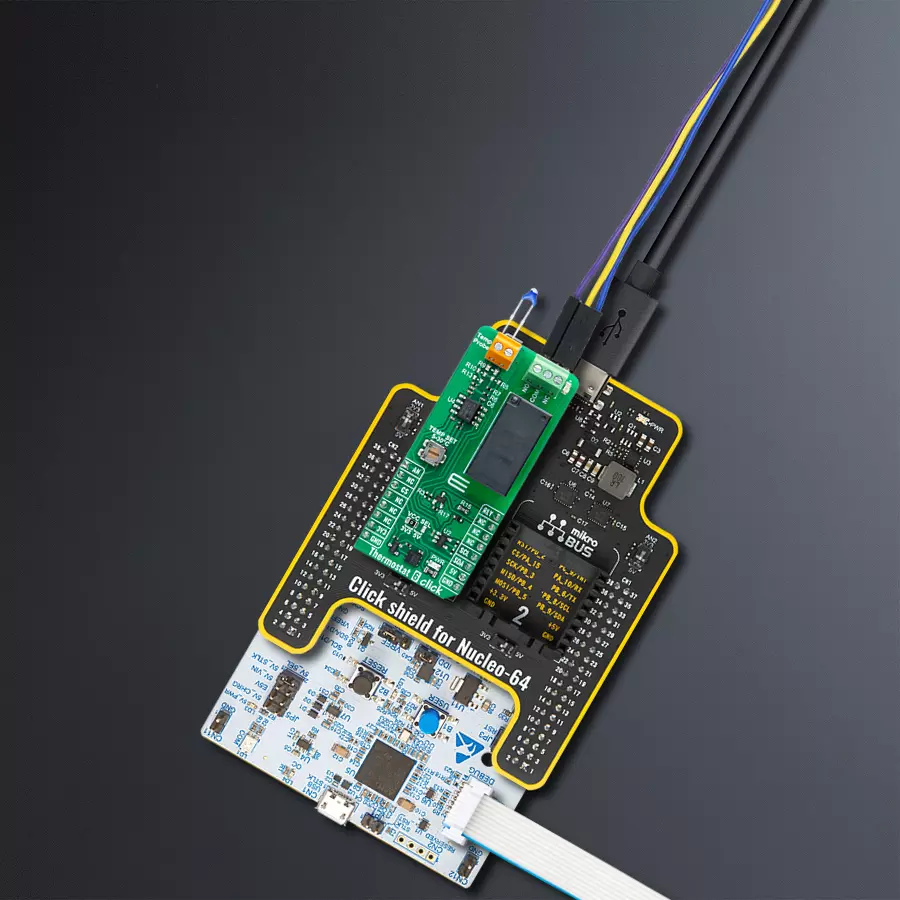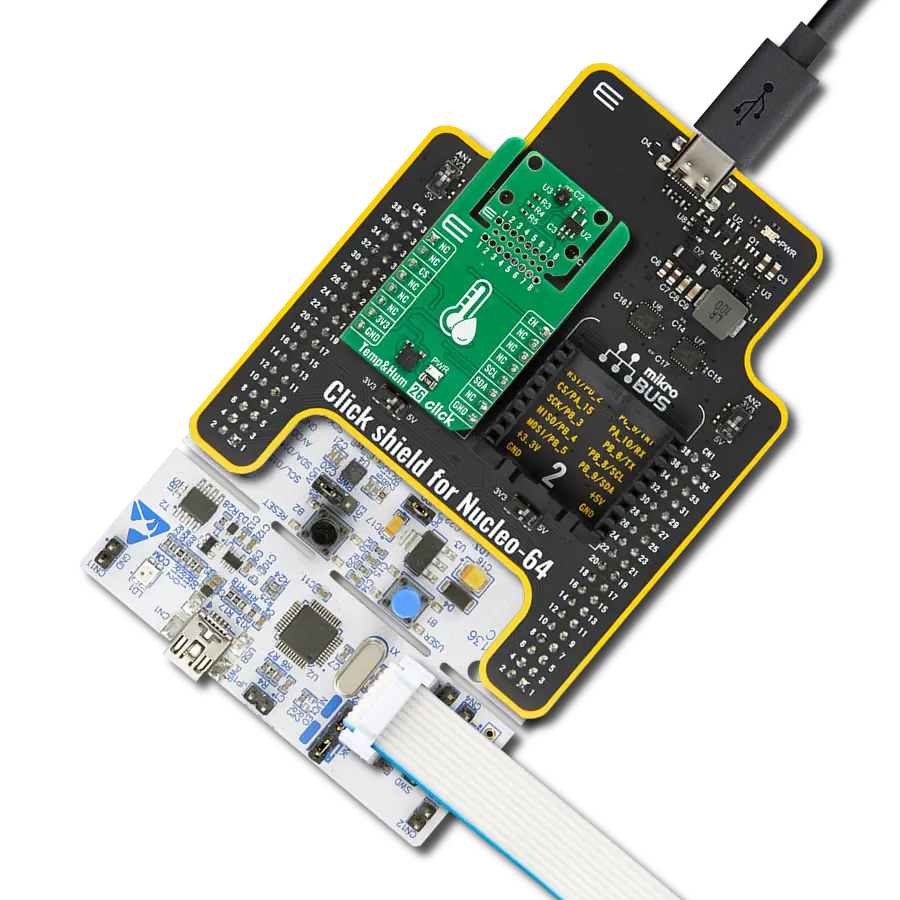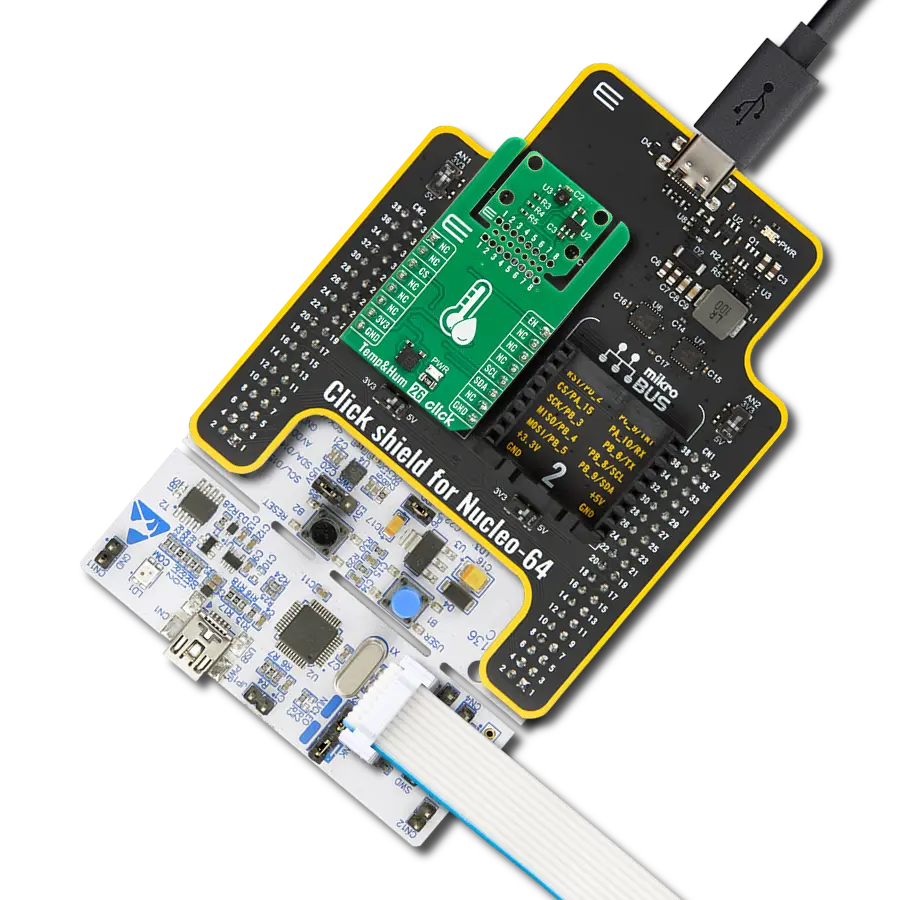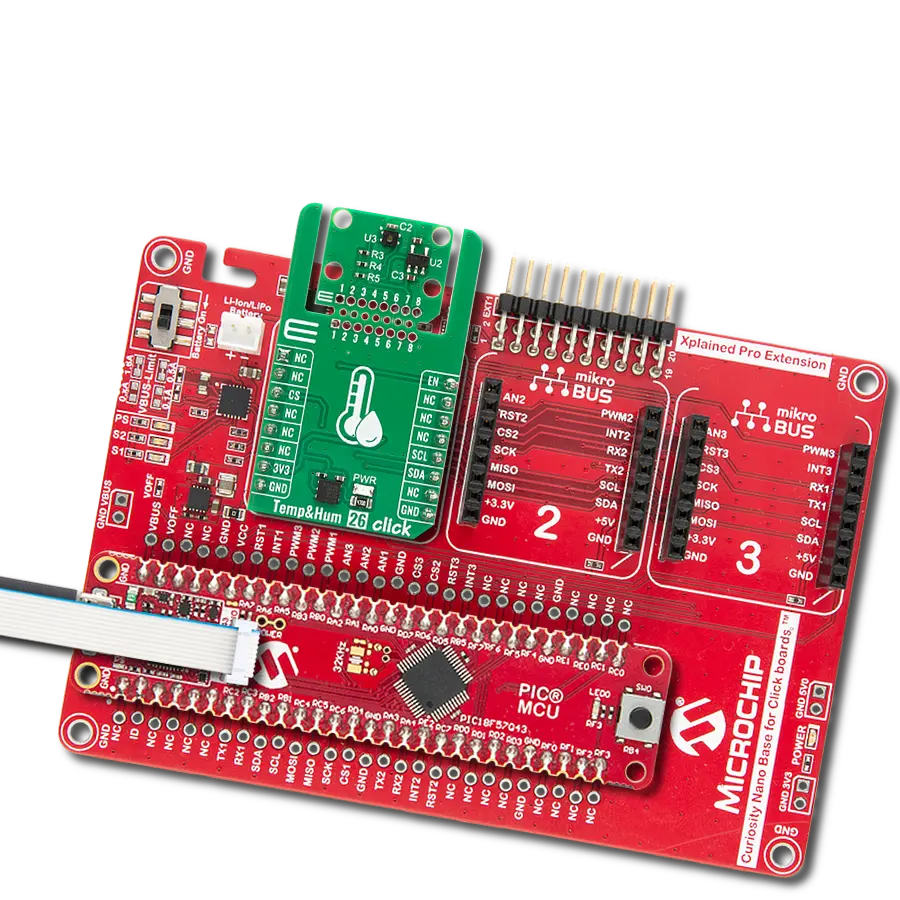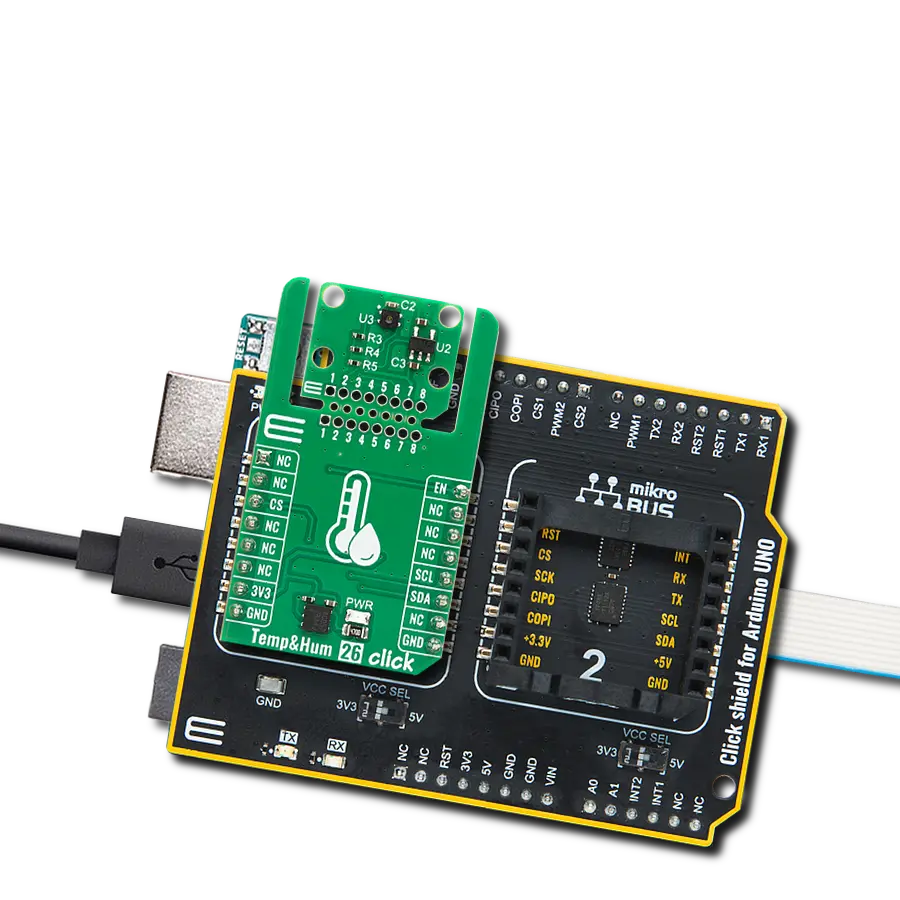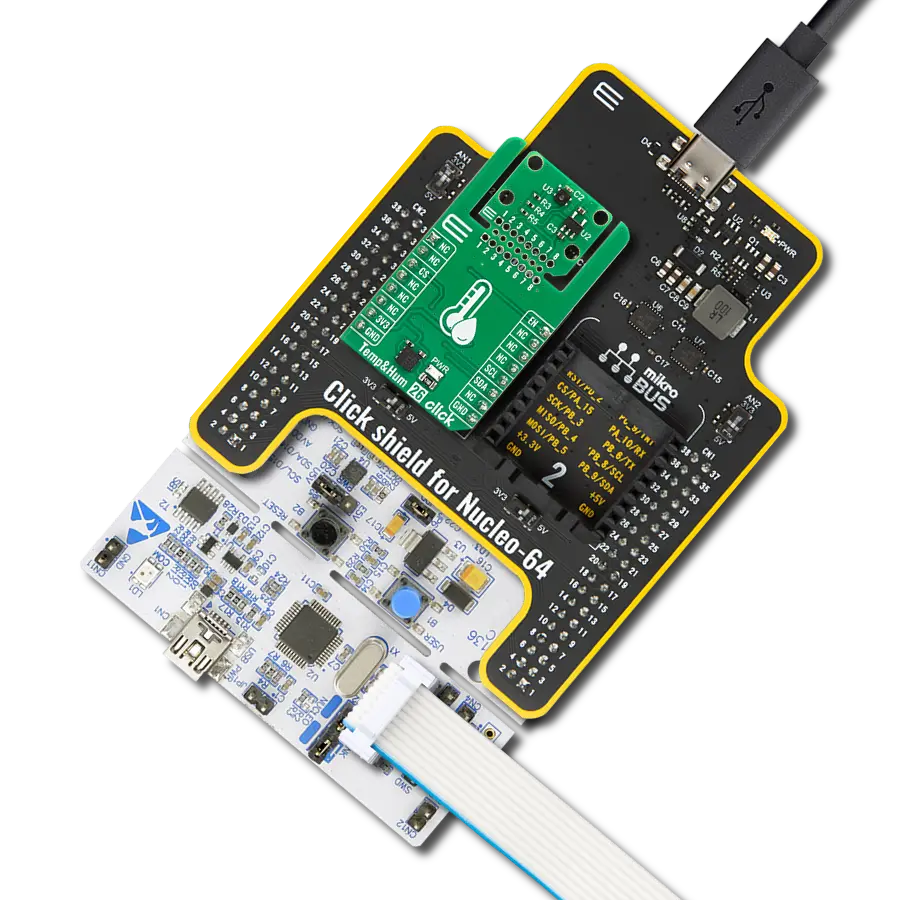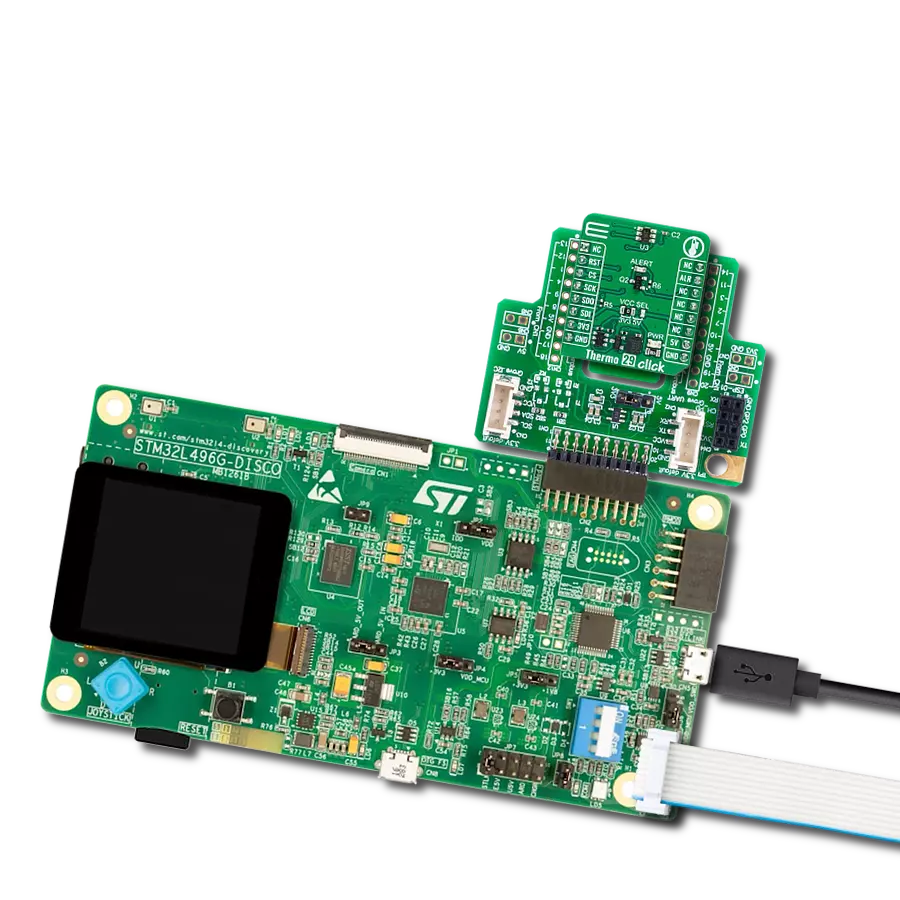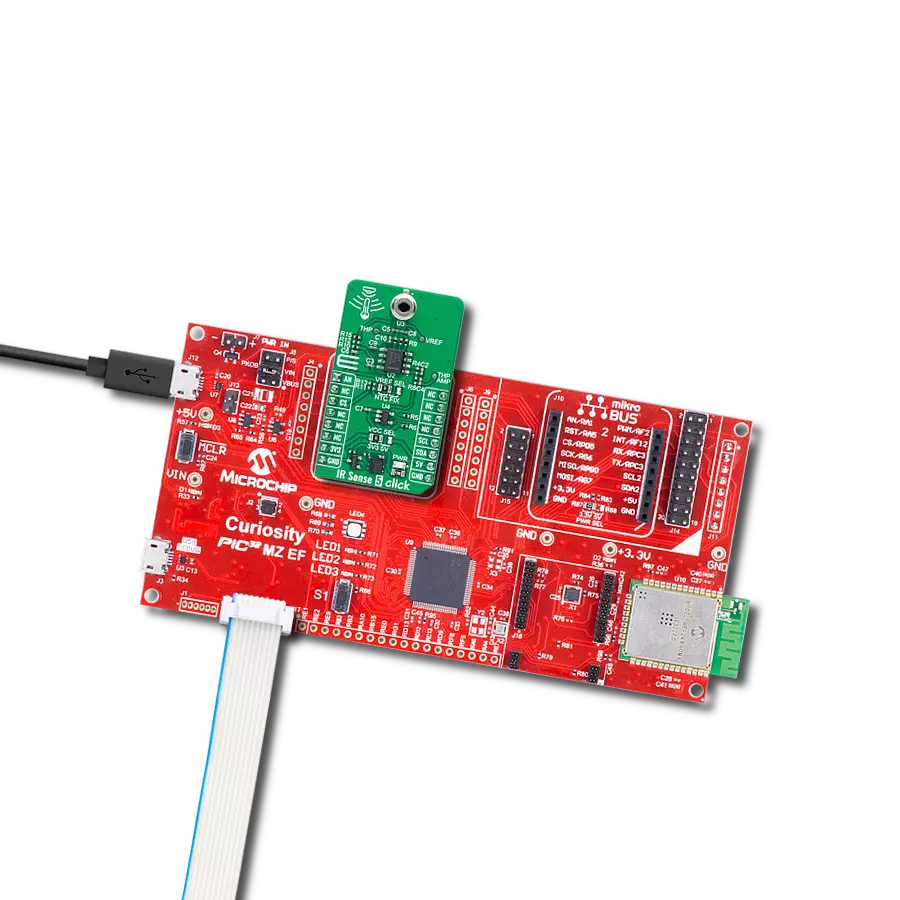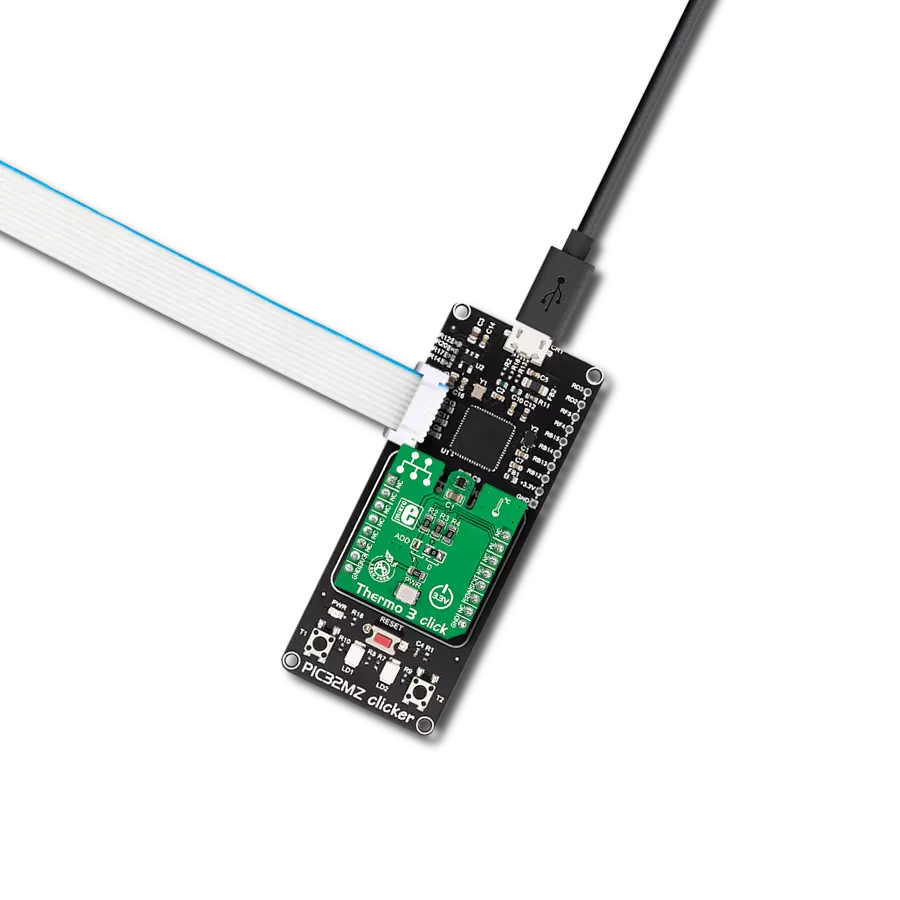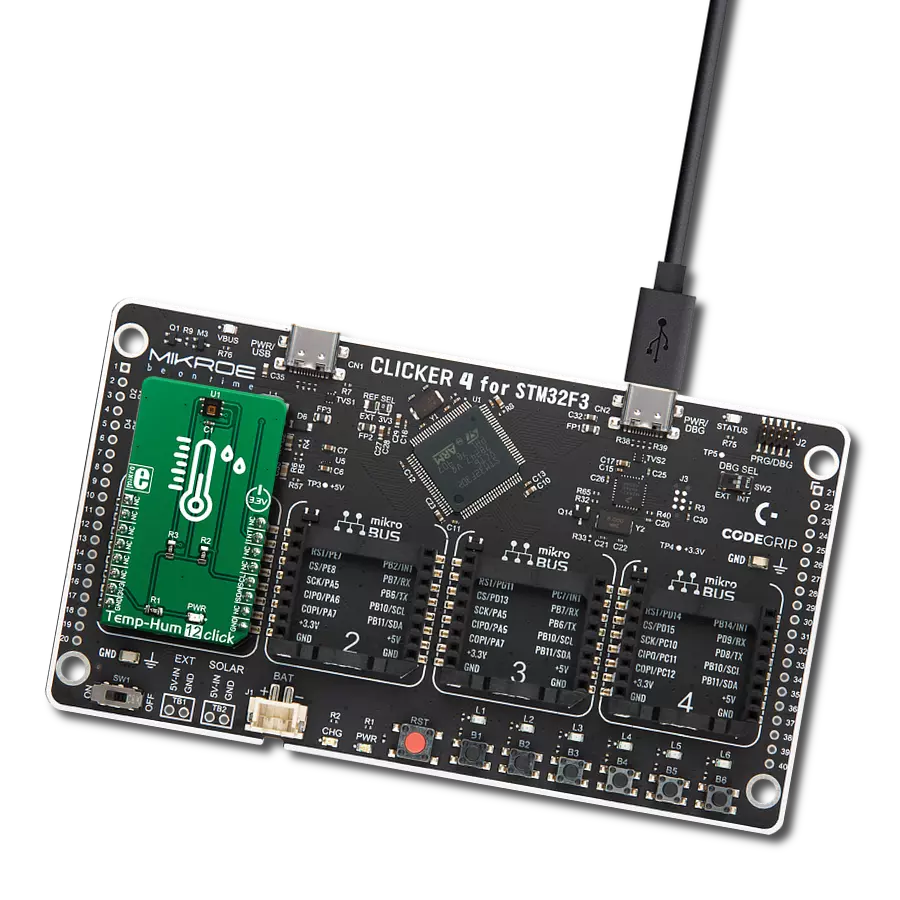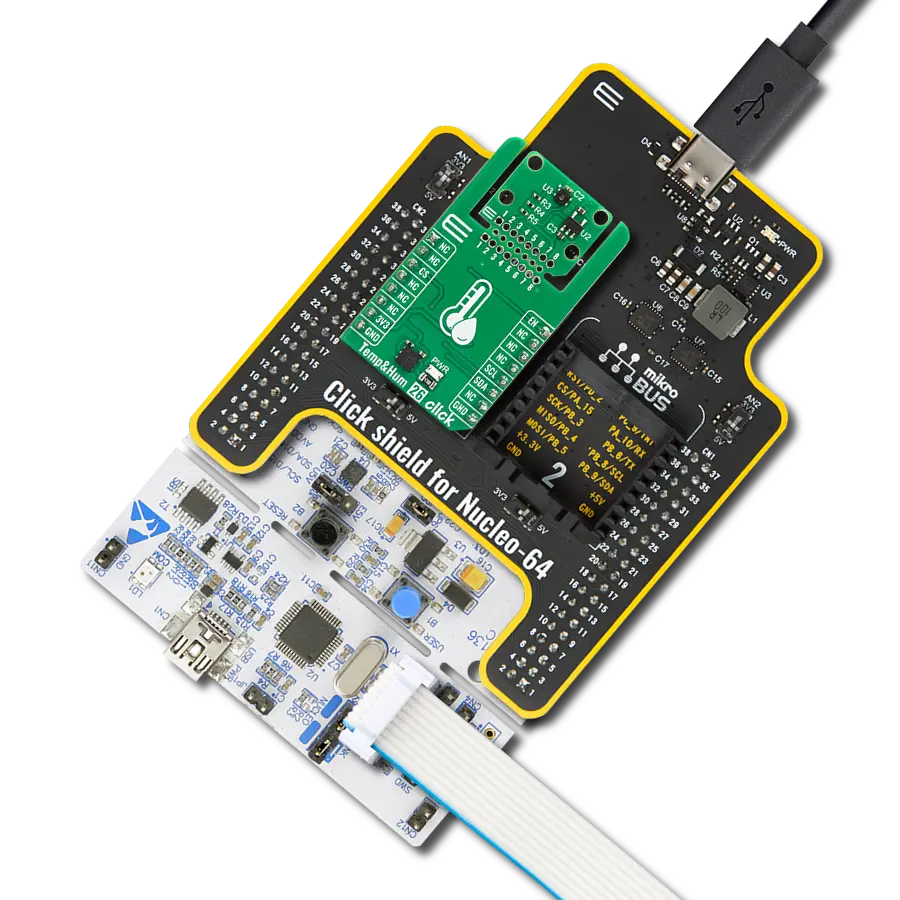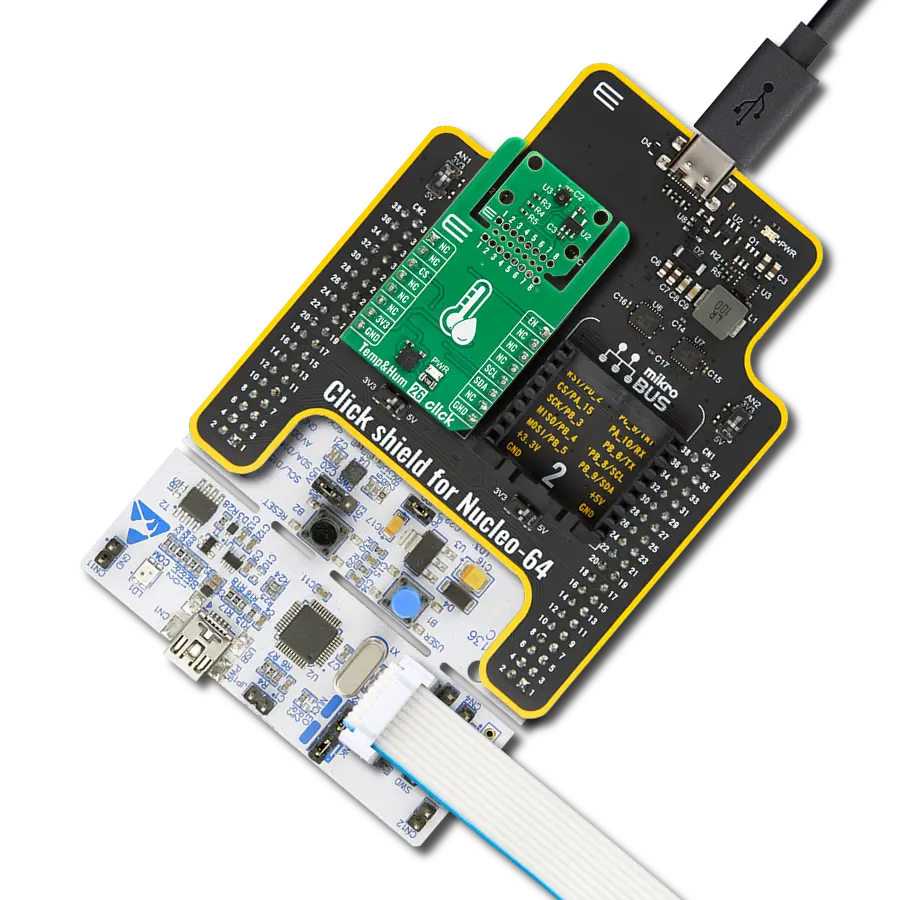Automate control based on precise temperature monitoring ideal for industrial automation, HVAC systems, and other temperature-sensitive applications
A
A
Hardware Overview
How does it work?
Thermostat 6 Click is an add-on board designed for precise temperature monitoring and control of external devices. At its core, it features a temperature probe connector for integrating an NTC thermistor or other RTD probe to measure temperature variations. The MCP6022 processes the probe's signal, a rail-to-rail input/output operational amplifier from Microchip, ensuring high precision and reliability in temperature monitoring. Besides accurate temperature measurement, this board also has an onboard trimmer for setting the desired operating temperature range between 5°C and 30°C. That's why this board is highly adaptable for various applications in industrial automation, HVAC systems, and other temperature-sensitive environments. The probe detects real-time temperature changes, while the trimmer allows
users to define a threshold temperature level. By comparing the probe's readings to the set threshold, the board activates or deactivates its relay, the AZ9403-1C-5DE SPDT from Zettler, enabling precise and automated control of external devices based on temperature conditions. The temperature limit set by the onboard trimmer can be monitored as an analog voltage output through the AN pin of the mikroBUS™ socket. The AZ9403-1C-5DE SPDT relay has a nominal coil voltage of 5VDC and a contact current rating of 10A, enabling it to control more powerful external devices. The relay's SPDT configuration offers flexibility in switching between normally open (NO) and normally closed (NC) positions while its activation is controlled via the RLY pin of the mikroBUS™ socket. An orange LED indicates the relay's
operational status visually, ensuring clear feedback and easy monitoring. The analog temperature value processed by the operational amplifier is directly digitized by the MCP3221 A/D converter, enabling precise digital monitoring of the temperature. This 12-bit resolution converter communicates with the host MCU via an I2C-compatible interface, providing accurate and reliable temperature data for further processing. This Click board™ can operate with either 3.3V or 5V logic voltage levels selected via the VCC SEL jumper. This way, both 3.3V and 5V capable MCUs can use the communication lines properly. Also, this Click board™ comes equipped with a library containing easy-to-use functions and an example code that can be used as a reference for further development.
Features overview
Development board
Nucleo-64 with STM32G474R MCU offers a cost-effective and adaptable platform for developers to explore new ideas and prototype their designs. This board harnesses the versatility of the STM32 microcontroller, enabling users to select the optimal balance of performance and power consumption for their projects. It accommodates the STM32 microcontroller in the LQFP64 package and includes essential components such as a user LED, which doubles as an ARDUINO® signal, alongside user and reset push-buttons, and a 32.768kHz crystal oscillator for precise timing operations. Designed with expansion and flexibility in mind, the Nucleo-64 board features an ARDUINO® Uno V3 expansion connector and ST morpho extension pin
headers, granting complete access to the STM32's I/Os for comprehensive project integration. Power supply options are adaptable, supporting ST-LINK USB VBUS or external power sources, ensuring adaptability in various development environments. The board also has an on-board ST-LINK debugger/programmer with USB re-enumeration capability, simplifying the programming and debugging process. Moreover, the board is designed to simplify advanced development with its external SMPS for efficient Vcore logic supply, support for USB Device full speed or USB SNK/UFP full speed, and built-in cryptographic features, enhancing both the power efficiency and security of projects. Additional connectivity is
provided through dedicated connectors for external SMPS experimentation, a USB connector for the ST-LINK, and a MIPI® debug connector, expanding the possibilities for hardware interfacing and experimentation. Developers will find extensive support through comprehensive free software libraries and examples, courtesy of the STM32Cube MCU Package. This, combined with compatibility with a wide array of Integrated Development Environments (IDEs), including IAR Embedded Workbench®, MDK-ARM, and STM32CubeIDE, ensures a smooth and efficient development experience, allowing users to fully leverage the capabilities of the Nucleo-64 board in their projects.
Microcontroller Overview
MCU Card / MCU
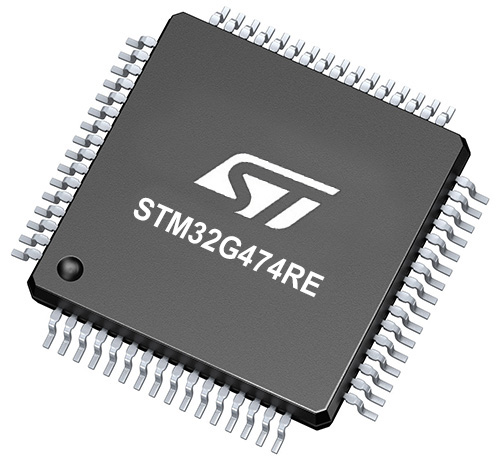
Architecture
ARM Cortex-M4
MCU Memory (KB)
512
Silicon Vendor
STMicroelectronics
Pin count
64
RAM (Bytes)
128k
You complete me!
Accessories
Click Shield for Nucleo-64 comes equipped with two proprietary mikroBUS™ sockets, allowing all the Click board™ devices to be interfaced with the STM32 Nucleo-64 board with no effort. This way, Mikroe allows its users to add any functionality from our ever-growing range of Click boards™, such as WiFi, GSM, GPS, Bluetooth, ZigBee, environmental sensors, LEDs, speech recognition, motor control, movement sensors, and many more. More than 1537 Click boards™, which can be stacked and integrated, are at your disposal. The STM32 Nucleo-64 boards are based on the microcontrollers in 64-pin packages, a 32-bit MCU with an ARM Cortex M4 processor operating at 84MHz, 512Kb Flash, and 96KB SRAM, divided into two regions where the top section represents the ST-Link/V2 debugger and programmer while the bottom section of the board is an actual development board. These boards are controlled and powered conveniently through a USB connection to program and efficiently debug the Nucleo-64 board out of the box, with an additional USB cable connected to the USB mini port on the board. Most of the STM32 microcontroller pins are brought to the IO pins on the left and right edge of the board, which are then connected to two existing mikroBUS™ sockets. This Click Shield also has several switches that perform functions such as selecting the logic levels of analog signals on mikroBUS™ sockets and selecting logic voltage levels of the mikroBUS™ sockets themselves. Besides, the user is offered the possibility of using any Click board™ with the help of existing bidirectional level-shifting voltage translators, regardless of whether the Click board™ operates at a 3.3V or 5V logic voltage level. Once you connect the STM32 Nucleo-64 board with our Click Shield for Nucleo-64, you can access hundreds of Click boards™, working with 3.3V or 5V logic voltage levels.
Epoxy Coated NTC Thermometer Sensor, the GA10K3A1IA from TE Connectivity, is a reliable, durable temperature sensing solution known for its high accuracy and dependable performance for precise thermal monitoring across various applications. This sensor features a tolerance β-value of ±0.5%, ensuring precise resistance-to-temperature measurements. Its lead wires, measuring 76mm (2.992 inches) in length, make it adaptable for easy integration into various systems. The sensor offers a resistance of 10kΩ at 25°C and operates efficiently across a broad temperature range, from -40°C to 125°C (-40°F to 257°F), with a maximum operating temperature of 125°C (257°F). With a β-value of 3976K (25/85), it delivers reliable performance for temperature-sensitive applications. Additionally, the sensor complies with EU RoHS and EU ELV regulations, ensuring it meets modern environmental and safety standards. Combining precision, durability, and compliance, the Epoxy Coated NTC Thermistor Sensor is ideal for use in industrial temperature monitoring, HVAC systems, automotive applications, and other environments requiring accurate and consistent thermal sensing. Its epoxy coating provides added protection, ensuring long-lasting performance even in demanding conditions.
Nickel-plated Brass NTC Thermistor Probe, the A1004BT22P0 thermistor from TE Connectivity, is a high-quality temperature sensor solution for various HVAC/R and surface sensing applications. This probe is known for its reliability and precision. Featuring a nickel-plated brass sensor package, it offers enhanced durability and resistance to environmental factors, making it suitable for demanding usage conditions. This thermistor probe incorporates a 22 AWG zipcord wire with an open-end electrical connection for versatile integration into various systems. The wire length of 3048mm (120 inches) ensures ample flexibility for installation in diverse setups. The probe’s resistance at 25°C is 10kΩ, with a high accuracy of ±0.2°C within a temperature range of 0°C to 70°C. It operates effectively across a broad temperature range from -40°C to 105°C (-40°F to 221°F), making it ideal for both extreme cold and high-temperature environments. The thermistor’s electrical characteristics include a β-value of 3976 K (25/85), contributing to its precise temperature-sensing capabilities. The device meets EU RoHS and EU ELV compliance standards, reflecting its environmentally friendly design and adherence to strict regulations. With its robust construction and reliable performance, this Nickel-plated Brass NTC Thermistor Probe is an excellent choice for applications requiring accurate and consistent temperature monitoring, particularly in heating, ventilation, air conditioning systems, and other surface temperature sensing tasks.
Used MCU Pins
mikroBUS™ mapper
Take a closer look
Click board™ Schematic

Step by step
Project assembly
Track your results in real time
Application Output
1. Application Output - In Debug mode, the 'Application Output' window enables real-time data monitoring, offering direct insight into execution results. Ensure proper data display by configuring the environment correctly using the provided tutorial.

2. UART Terminal - Use the UART Terminal to monitor data transmission via a USB to UART converter, allowing direct communication between the Click board™ and your development system. Configure the baud rate and other serial settings according to your project's requirements to ensure proper functionality. For step-by-step setup instructions, refer to the provided tutorial.

3. Plot Output - The Plot feature offers a powerful way to visualize real-time sensor data, enabling trend analysis, debugging, and comparison of multiple data points. To set it up correctly, follow the provided tutorial, which includes a step-by-step example of using the Plot feature to display Click board™ readings. To use the Plot feature in your code, use the function: plot(*insert_graph_name*, variable_name);. This is a general format, and it is up to the user to replace 'insert_graph_name' with the actual graph name and 'variable_name' with the parameter to be displayed.

Software Support
Library Description
Thermostat 6 Click demo application is developed using the NECTO Studio, ensuring compatibility with mikroSDK's open-source libraries and tools. Designed for plug-and-play implementation and testing, the demo is fully compatible with all development, starter, and mikromedia boards featuring a mikroBUS™ socket.
Example Description
This example demonstrates the use of Thermostat 6 Click board by reading the temperature level set using an on-board potentiometer and the temperature from the NTC Thermistor 10k Cylindrical Probe (B57500M0103A005) which is connected to the input, and also displaying the relay state. If the set temperature level is lower than the temperature read from NTC, then the relay switches ON.
Key functions:
thermostat6_cfg_setup- Config Object Initialization function.thermostat6_init- Initialization function.thermostat6_get_adc_v_avg- This function reads and averages the ADC voltage for a desired number of samples.thermostat6_get_an_pin_v_avg- This function reads and averages the AN pin voltage for a desired number of samples.thermostat6_get_temperature- This function calculates temperature in degrees Celsius based on a voltage input using the NTC Thermistor 10k Cylindrical Probe (B57500M0103A005) R/T characteristics map.
Application Init
Initializes the driver and logger.
Application Task
Reads the temperature level set using an on-board potentiometer and the temperature from the NTC Thermistor 10k Cylindrical Probe (B57500M0103A005) connected to the input, and displays the relay state. If the set temperature level is lower than the temperature read from NTC, then the relay switches ON.
Open Source
Code example
The complete application code and a ready-to-use project are available through the NECTO Studio Package Manager for direct installation in the NECTO Studio. The application code can also be found on the MIKROE GitHub account.
/*!
* @file main.c
* @brief Thermostat 6 Click Example.
*
* # Description
* This example demonstrates the use of Thermostat 6 Click board by reading
* the temperature level set using an on-board potentiometer and the temperature
* from the NTC Thermistor 10k Cylindrical Probe (B57500M0103A005) which is connected
* to the input, and also displaying the relay state. If the set temperature level
* is lower than the temperature read from NTC, then the relay switches ON.
*
* The demo application is composed of two sections :
*
* ## Application Init
* Initializes the driver and logger.
*
* ## Application Task
* Reads the temperature level set using an on-board potentiometer and the temperature
* from the NTC Thermistor 10k Cylindrical Probe (B57500M0103A005) connected to the input,
* and displays the relay state. If the set temperature level is lower than the temperature
* read from NTC, then the relay switches ON.
*
* @author Stefan Filipovic
*
*/
#include "board.h"
#include "log.h"
#include "thermostat6.h"
static thermostat6_t thermostat6; /**< Thermostat 6 Click driver object. */
static log_t logger; /**< Logger object. */
void application_init ( void )
{
log_cfg_t log_cfg; /**< Logger config object. */
thermostat6_cfg_t thermostat6_cfg; /**< Click config object. */
/**
* Logger initialization.
* Default baud rate: 115200
* Default log level: LOG_LEVEL_DEBUG
* @note If USB_UART_RX and USB_UART_TX
* are defined as HAL_PIN_NC, you will
* need to define them manually for log to work.
* See @b LOG_MAP_USB_UART macro definition for detailed explanation.
*/
LOG_MAP_USB_UART( log_cfg );
log_init( &logger, &log_cfg );
log_info( &logger, " Application Init " );
// Click initialization.
thermostat6_cfg_setup( &thermostat6_cfg );
THERMOSTAT6_MAP_MIKROBUS( thermostat6_cfg, MIKROBUS_1 );
err_t init_flag = thermostat6_init( &thermostat6, &thermostat6_cfg );
if ( ( ADC_ERROR == init_flag ) || ( I2C_MASTER_ERROR == init_flag ) )
{
log_error( &logger, " Communication init." );
for ( ; ; );
}
log_info( &logger, " Application Task " );
}
void application_task ( void )
{
float voltage = 0;
if ( THERMOSTAT6_OK == thermostat6_get_an_pin_v_avg ( &thermostat6, &voltage, THERMOSTAT6_ADC_NUM_SAMPLES_50 ) )
{
log_printf( &logger, " Set temperature : %.2f[degC]\r\n", thermostat6_get_temperature ( voltage ) );
}
if ( THERMOSTAT6_OK == thermostat6_get_adc_v_avg ( &thermostat6, &voltage, THERMOSTAT6_ADC_NUM_SAMPLES_50 ) )
{
log_printf( &logger, " Read temperature : %.2f[degC]\r\n", thermostat6_get_temperature ( voltage ) );
}
if ( thermostat6_get_relay_pin ( &thermostat6 ) )
{
log_printf( &logger, " Set temperature is lower than read temperature! Relay: ON\r\n\n" );
}
else
{
log_printf( &logger, " Set temperature is higher than read temperature! Relay: OFF\r\n\n" );
}
Delay_ms ( 1000 );
}
int main ( void )
{
/* Do not remove this line or clock might not be set correctly. */
#ifdef PREINIT_SUPPORTED
preinit();
#endif
application_init( );
for ( ; ; )
{
application_task( );
}
return 0;
}
// ------------------------------------------------------------------------ END
Additional Support
Resources
Category:Temperature & humidity
